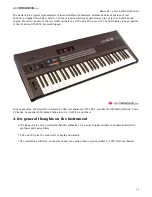
140
CHAPTER 11
The Virus and Sequencers
DUMP - THE SOUND IN THE
SONG
Archiving all of the sounds used in a song is not
only a good idea to prevent potential problems
that may occur when parameters are controlled
in real time. It also makes it easy for you to re-
call your work at some later point. Assuming
that you’ve connected the MIDI Out of the Virus
with a MIDI In of the computer, you can, for ex-
ample, at any time send an individual sound or
the content of the entire memory via MIDI in the
form of something called a bulk dump to the se-
quencer and record this data there. This has an
distinct advantage: all sound data can be
stored together with the song and the status of
the Virus required for this song can be restored
at any time by simply sending the recorded da-
ta to the device. You’ll find the menu for SysEx
dumps by going to the CTRL menu and then
MIDI DUMP TX.
When you opt to record a bulk dump to a se-
quencer, you can proceed in the same manner
as you would when you record tracks consist-
ing of notes. For example, you can move a bulk
dump to any position in the arrangement. To as-
sure that the Virus plays the song back using
the right sounds, we recommend that you posi-
tion stored data prior to the song. Move all
components of the actual song back so that
you’re left with enough room to accommodate
the dump prior to the song’s start position.
Then when you start the sequencer on the first
bar, sound-related data is sent to the Virus be-
fore the actual song begins. An individual sound
dump is very short; a dump comprising a com-
plete memory bank will extend over several
bars.
During a bulk dump, the Virus sends MIDI
SysEx data to the computer. If you encounter
problems while recording a bulk dump, please
check if your sequencer refuses to accept Sy-
sEx data due to one-sided filtering. You can
check whether or not anything was recorded by
taking a look at the Event or List editor of your
sequencer. In this editor, MIDI data is displayed
numerically instead of graphically; in a normal
Note editor (Key Edit, Matrix Edit or the like) Sy-
sEx data is NOT visible. Once you’ve success-
fully recorded a dump, look for entries in the list
that are labeled ”SysEx”.
The Virus lets you to send the entire memory
content or just parts thereof to the sequencer.
The most reliable solution is to transfer the en-
tire memory (MIDI DUMP TX: Total). There is,
however, a catch: Since a great deal of data is
being transmitted (”Total”, after all, means all
SINGLE programs, all MULTIs, and so forth),
the dump is very extensive and takes quite
some time. Alternatively, you can also send just
individual sounds, MULTIs or so-called ”ar-
rangements”.
The other truly reliable option for archiving
sounds is dumping an arrangement (MIDI
DUMP TX: Arrangement). In this case, the cur-
rent MULTI is transmitted. Since a MULTI con-
tains the addresses of SINGLE sounds used in
the arrangement rather than the actual SIN-
GLEs, the sounds of all active PARTs are sent
separately (for more info on this, see the section
on MULTIMODE). This option is convenient and
fast, but has an inherent drawback: this type of
arrangement dump does not take into account
that your song uses program change messages
to change sounds in the MULTI. Only the eight
sounds to which the MULTI refers in the ar-
rangement are sent, which is to be expected
when you consider that the Virus can’t antici-
pate that you intend to change these at some
point during playback.
Dumping an arrangement is a great option
when you’re able to make do with the sixteen
sounds to which the MULTI refers. If you want
Summary of Contents for Virus Rack XL
Page 1: ...ENGLISH VERSION ...
Page 3: ......
Page 7: ...ACCESS VIRUS RACK XL OS5 7 PDF VERSION RESTRICTIONS APPLY ...
Page 10: ...10 CHAPTER 3 ...
Page 11: ...Prologue ...
Page 14: ...14 CHAPTER 4 Prologue ...
Page 15: ...Introduction ...
Page 26: ...26 CHAPTER 5 Introduction Her is the filter routings capabilities of the Virus ...
Page 39: ...Concept and Operation ...
Page 56: ...56 CHAPTER 6 Concept and Operation ...
Page 57: ...The Parameters ...
Page 113: ...The Multi Mode Parameters ...
Page 118: ...118 CHAPTER 8 The Multi Mode Parameters ...
Page 119: ...The Global Parameters ...
Page 129: ...The Vocoder ...
Page 134: ...134 CHAPTER 10 The Vocoder ...
Page 135: ...The Virus and Sequencers ...
Page 142: ...142 CHAPTER 11 The Virus and Sequencers ...
Page 143: ...Tips Tricks Words Of Wisdom ...
Page 156: ...156 CHAPTER 12 Tips Tricks Words Of Wisdom ...
Page 157: ...Appendix ...
Page 188: ...188 CHAPTER 13 Appendix ...
Page 189: ...Index ...














































